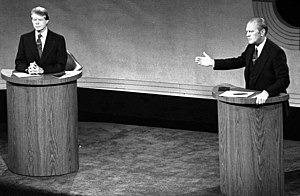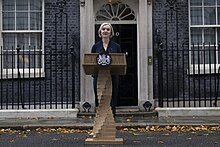Lectern
To facilitate eye contact and improve posture when facing an audience, lecterns may have adjustable height and slant.
The word has its origins in the medieval Latin term lectrum, related to legere which means 'to read'.
"[2] One 1905 dictionary states that "the term is properly applied only to the class mentioned [church book stands] as independent of the pulpit.
"[3] By the 1920s, however, the term was being used in a broader sense; for example, in reference to a memorial service in Carnegie Hall, it was stated that "the lectern from which the speakers talked was enveloped in black.
Lecterns of this sort are generally attached or integrated into a large desk, as the amount of support material tends to be larger in academic contexts than in straightforward public talks.
[citation needed] In the Christian Church, the lectern is usually the stand on which the Bible or other texts rest and from which the "lessons" (scripture passages, often selected from a lectionary) are read during the service.
The lessons may be read or chanted by a priest, deacon, minister, or layperson, depending upon the liturgical traditions of the community.
[8] In traditional yeshivas and some synagogues, students and members of the congregation may use small desks called shtenders (Yiddish: שטענדער).
[14] While they are designed in a wide variety of variations, lecterns usually feature a sloped top on which to rest the material to be read.




